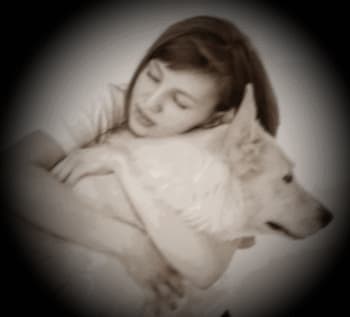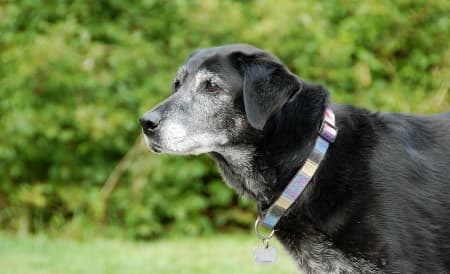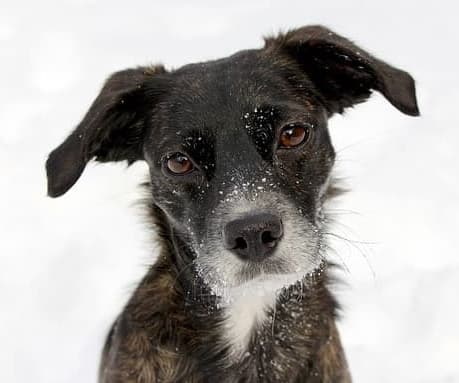Older Dog Care -Tips For Healthy Aging

If you're looking for information about older dog care, chances are you furry friend is not as feisty as he once was.
Sad as it may be to hear, dogs are considered seniors at around the age of six or seven. While there may be some exceptions due to hereditary factors and differences between breeds, this is a good time to start watching for physical and behavioral changes in your pet.
 Dogs at Sunset
Dogs at SunsetIt seems like only yesterday he was a puppy, today he's your aging dog, but still just as special and beloved. Time flies.
When Does Older Dog Care Begin? - Sooner Than You Think!
When dogs enter their senior years, they need your compassion and loving attention more than ever. It is a necessary commitment that goes hand in hand with dog ownership. In other words, it's time to think about what you can do for your older dog.
With some dog breeds, you'll need to be particularly observant for signs of age-related conditions such as arthritis and other joint related conditions.
I'm speaking of those dogs with a high pain tolerance, that are able to carry on as normal showing no signs of any discomfort they may be enduring.
While retrievers and terriers are typically in this
category, many dogs hide their pain to avoid showing weakness to predators- something learned long ago.

Make Home Checkups Part of Older Dog Care
An ounce of prevention is worth a pound of cure, so the saying goes, and there's a lot of truth in that statement. The best way to spot changes and common dog health problems in your dog no matter what his age, is to learn how to give a weekly checkup.
It's a good habit to get into right from puppyhood and definitely
a habit to include in your weekly older dog care schedule.
When you do
this you'll be able to notice subtle differences in his condition that may indicate a problem. Early
discovery of a potential dog illness can make all the difference in curing or managing it.
Not only that, but you may just be saving your senior dog from a lot of needless suffering - something really worthwhile for your best friend!
How To Give Your Dog A Checkup
We'll go over that in just a bit. Or, you can schedule a visit to the vet and have him demonstrate how to check your dog's vital signs so you'll be able to tell what is normal vs. abnormal.
Things like, pulse, temperature, respiration, circulation and fluids. Once you start doing this at home, keep a journal to record the information so you'll have an accurate record from week to week.
 Love Them Young And Old
Love Them Young And Old
Early Detection Can Save A Pet's Life
As mentioned earlier, your dog's vital signs are fairly simple to track on a week-to-week basis, and good overview of his current health.
Record your findings in a notebook, like the pet planner, as part of your older dog care - here's how to go about it:
Older Dog Care - The Vital Signs
Yes, they are vital, as these signs serve as indicators of your dog's health. If you start recording them from a young age, or at a time when they are in good health, you'll have a head's up if there are any changes.
Temperature
Let's start with the dog's temperature, which normally falls between 99.5° and 102.5°. A fever would be
indicated at a temperature above 103°. If you're not the nervous type or too squeamish, you can take the
temperature with a lubricated rectal thermometer.
But, an even better non-invasive option, that works immediately, is the No-contact Pet Thermometer
that is designed to take a reading when held over a part of your dog's body. Great for nervous older dogs and their owners!
His Heart Beats For you, So Check Your Older Dog's Pulse
OK, now that's done, let's move on to the pulse to find out what's going on with the heart.
This is where it will come in handy to ask the vet what
is normal for your breed of dog, because it can vary between size and breed.

So once you have that information, what you are looking for is a strong and regular beat. You can check the beats in either of two locations.
One is inside the upper thigh on your dog's rear legs, which is where you'll find
the femoral artery.
The other is on the chest behind the left leg, where their left elbow meets the body.
This spot, known as the point of maximal impulse (PMI), is
one of the best places to feel the pulse.
To be sure you're in the right place, count the ribs to find your way to the heart. Dogs have 13 pairs of ribs. Begin at the last rib and work towards ribs 7, 6, 5, and 4. Here you should quite easily feel the pulse with your finger in this area.
Count the beats per minute - actually you can do it for 15 seconds and then do the math, times 4.
If you have any challenges taking your dog's pulse such as he won't sit still long enough, or he is a bit overweight to get a read, you can perform the heart beat check with a veterinary blood pressure monitor for pets.
Normal beats can fall in the 60-150 range, but don't jump to any conclusions until you
know what is normal for your breed of dog as I mentioned earlier.
Respiration
Respiration, or in other words breathing, is another
good health indicator to review. Do this when your dog is in a relaxed state, not after he's been playing
fetch or is panting due to summer heat etc.
It is even better to count when the pet is asleep
to get an accurate respiratory rate, but don't touch him while you do this as it would likely cause a false count.
A respiration means one breath in and out.In other words, one breath includes one inhalation (breath in) and one exhalation (breath out).
Once you know what is normal for your aging dog, it will be easy for you to spot any distress or changes in his breathing. The average range is around 10-30 breaths a minute, but again it varies according to breed and size.
You can visually do a 15-second count of the breaths, or use a stopwatch, then multiply by 4 to get the one minute result. You should also observe the effort involved which should be hardly any in a resting healthy dog. If you see anything that looks abnormal, there may be something wrong needing a visit to your vet.

Circulation
Another health indicator is circulation which can be affected in aging
dogs. Just as with humans, the blood must be carried efficiently around
your dog's body to deliver nutrients to the tissues.
You can check out your dog's circulation by lifting his lip and pressing
a finger on the gum line above the canine tooth. When you take your
finger away, count how many seconds it takes for the gum to return to
its normal pink color.
More than a couple of seconds is an indicator of
a problem and you should talk to your vet as soon as possible.
While checking his gums, use the opportunity to also look over the condition of his teeth for any signs of
dental problems or excessive tartar build-up.
Dental health is especially important to all dogs. Any problems,
left unattended, can result in infections, which in turn can cause
serious conditions if they get into the bloodstream.
Older Dog Care and Hydration Levels

Water, as we know, is necessary for all life forms to exist. Observing your dog's water intake as well as
checking his hydration levels can give you life saving information.
I know the importance of this because it led me to discovering my dog's diabetes. Don't hesitate to talk to your vet if you notice a sudden and
significant increase in your dog's water consumption.
Here's a simple way to check for dehydration
in your older dog. It's often referred to as the tenting test. Just pull up some skin around your dog's neck and
then release. It should fall back to normal right away if enough fluids are present.
However, if your dog
is dehydrated, the skin loses its elasticity and remains in a tented position, taking longer to return to
normal. Any sign of dehydration, which can be life threatening, is reason to call your vet.
Hands On "Pampering" Exam
After you have completed the measured health stats, follow up with a hands on examination and visual once-over of your senior pet. If
your dog has become used to your tender touch, and most likely he has, then he'll just think he getting some extra pampering.
So run your
hands over his joints, back, and belly for signs of discomfort or swelling, and check his eyes, ears and
bottom for any signs of infection or parasites.
Don't overlook the paws, as this is a prime location to inspect for embedded foreign matter or hidden abrasions.
 Sweet Sixteen
Sweet SixteenSummary
And finally a few last tips.
As part of your older dog care routine, be sure to check your dog's breath for any difference other than the usual doggy smell. If there are no obvious dental issues, bad breath can be an indicator of other serious conditions such as diabetes or kidney problems.
Inevitably in our beloved older dogs, there will be some
physical signs of aging. Stiff joints or arthritis are common dog health problems, but there is a lot that can be done to ease the pain of these conditions. Fox example, if you haven't already started with hip and joint supplements, now is a good time to begin.
Hearing and eye problems
can also be issues and sometimes there are changes in behavior. Owners
will spot these signs and be able to respond to them quickly if they
implement a weekly inspection routine.
The good news is, dogs are living far longer these days thanks to incredible advances in veterinary
medicine. So make the most of their golden years.
Once you become very familiar with the routine indicators of your senior
dog's life, including what goes in and what comes out, you will quickly
notice any changes that occur.
With compassion, there is so much we can do to make our senior dog's life comfortable and enjoyable. And,
this is the greatest gift a master can give his loyal friend.

Note: Although this article was written with the senior dog in mind, the suggested check-ups are highly recommended for dogs of all ages.
- Always consult your veterinarian when you have health-related questions or you think your dog is sick. Information on this website is not intended to replace the advice of a qualified professional. The information above is designed to help inform you about the topic..
Using this information is at your own discretion and we will not be liable for any actions taken by any person or any consequences that may result.
Helpful Related Pages
Image:"sweet sixteen!"by looseends is licensed under CC BY-NC-SA 2.0

NOTE: Information on this website is not intended to take the place of advice from a veterinarian.
More information about older dog care can be found here

